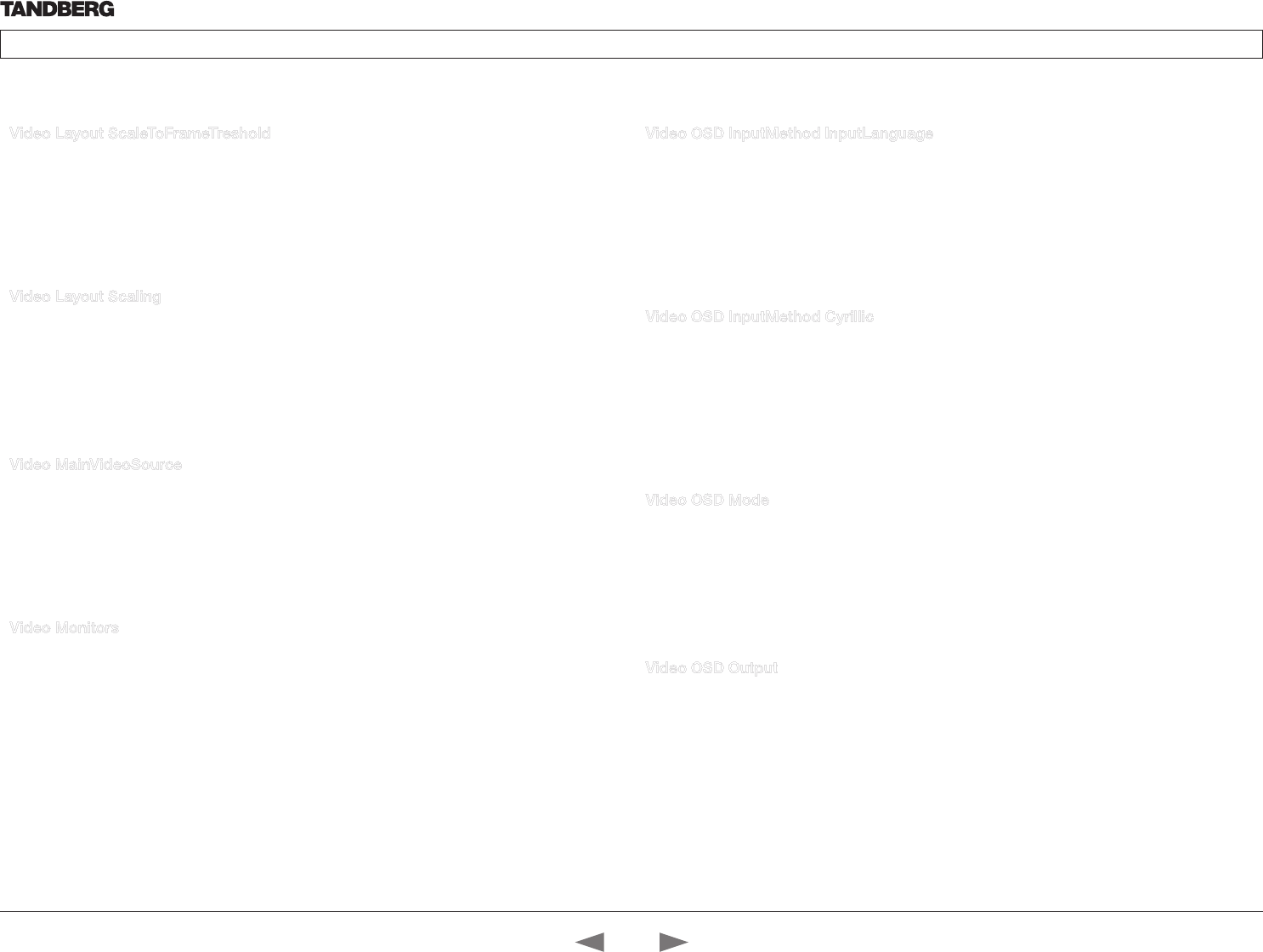
D14635.02—MARCH 2010
33
TANDBERG Codec C90 and Profiles using C90
Administrator guide
Contents Introduction Advanced configuration Password protection About monitors Audio matters Appendices Contact us
www.tandberg.com
Video Layout ScaleToFrameTreshold
Only applicable if the ScaleToFrame configuration is set to manual. If the difference in aspect ratio between
the video input source and the target image frame is less than the ScaleToFrameThrshold configuration (in
percent), the image is stretched to fit. Unless the system will maintain the original aspect ratio.
Valuespace: <0..100>
Range: Select a value from 0 to 100 percent.
Example: Video Layout ScaleToFrameTreshold: 5
Video Layout Scaling
Defines whether the system should automatically adjust aspect ratio for images or frames when it differs
between the image and the frame it is to be placed in.
Valuespace: <On/Off>
On: Let the system automatically adjust aspect ratio.
Off: Do not do any aspect ratio changes automatically.
Example: Video Layout Scaling: On
Video MainVideoSource
Define which video input source shall be used as the main video source. The input source is configured to
a video input connector. See the Video Input Matrix table at the back of the codec and the description of
the Video Input Matrix in the Interfaces section.
Valuespace: <1..5>
Range: Select one of the five video sources
Example: Video MainVideoSource: 1
Video Monitors
The codec can be used with more than one monitor and this setting lets you set the codec’s monitor
layout mode to single, dual, presentation only on the dual monitor, or quadruple.
Valuespace: <Single/Dual/DualPresentationOnly/Quadruple>
Single: The same layout is shown on all monitors.
Dual: The layout is distributed on two monitors.
DualPresentationOnly: All participants in the call will be shown on the first monitr, while the presentation
(if any) will be shown on the second monitor.
Quadruple: The layout is distributed on four monitors, so that each remote participant and the
presentation will be shown on separate monitors
Example: Video Monitors: Single
Video OSD InputMethod InputLanguage
The codec can be enabled for Cyrillic input characters in the GUI (Graphical User Interface). NOTE:
Requires that Video OSD inputMethod Cyrillic is set to On.
Valuespace: <Latin/Cyrillic>
Latin: Latin characters can be entered when using the remote control (default setting).
Cyrillic characters can be entered using the remote control. NOTE: Requires a TANDBERG Remote
Control TRC5 with Cyrillic fonts.
Example: Video OSD InputMethod InputLanguage: Latin
Video OSD InputMethod Cyrillic
This configuration is used to hide or show the Cyrillic mode as menu input language in the GUI (Graphical
User Interface).
Valuespace: <On/Off>
On: Cyrillic mode is available as a menu input language in the GUI. This will enable the setting Video
OSD InputMethod InputLanguage.
Off: Cyrillic mode is NOT available as a menu input language in the GUI.
Example: Video OSD InputMethod Cyrillic: Off
Video OSD Mode
The Video OSD (On Screen Display) Mode lets you define whether or not information and icons on screen
should be displayed.
Valuespace: <On/Off>
On: Set to On to display the on screen menus, icons and indicators.
Off: Set to Off to hide the on screen menus, icons and indicators.
Example: Video OSD Mode: On
Video OSD Output
The Video OSD (On Screen Display) Output lets you define which monitor should display the on screen
menus, information and icons. By default the OSD output is displayed on the first monitor.
If you have a single monitor and you cannot see any OSD on the monitor: If the OSD output has been
set to the second monitor and the second monitor is not connected, then you cannot see any menus,
information or icons on the screen. To move the OSD output to the first monitor press the following
shortcut sequence on the remote control. Press the Disconnect key followed by: * # * # 0 x # (where x is
output 1 to 4).
Valuespace: <1..4>
Range: Select 1 for HDMI 1 output, select 2 for DVI-I 2 output, select 3 for HDMI 3 output, or select 4
for DVI-I 4 output.
Example: Video OSD Output: 1
The Video settings, cont... The Video settings, cont...
